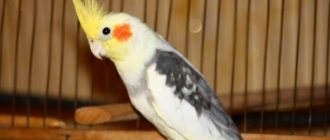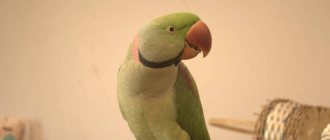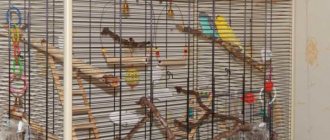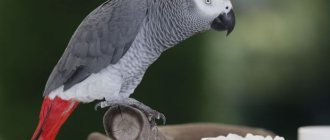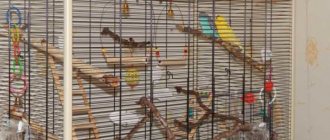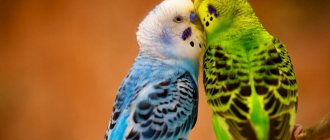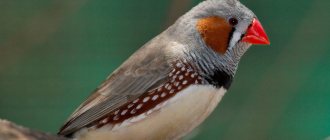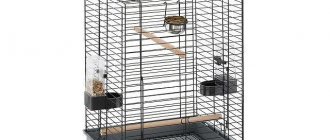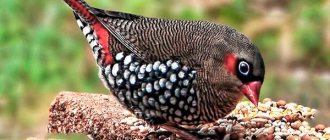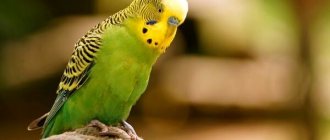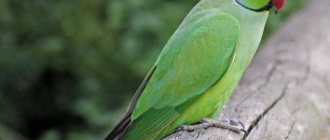Preliminary preparation
Before purchasing and bringing home a new tenant, you need to carefully consider keeping your cockatiel and prepare everything that the parrot needs for a safe and comfortable stay.
Required Items
For any, even the most tame bird, it is important to have its own home, a cage. This is the first thing that owners should buy for their pet, because he will not always move around the rooms freely.
Equipment that must be present in the cage:
- drinking bowl;
- one or more feeders;
- parrot bathing container;
- several perches;
- various toys.
All these devices must be made of safe materials and have high-quality processed edges so that the bird does not get hurt on them.
The drinker and feeder must be securely fastened so that they do not fall under the weight of the bird. It is better to position them so that the parrot can reach them from the perch. The most preferred material for perches is wood. You can make them yourself. There is no need to peel them from the bark; the bird will happily do this itself.
Cockatiels love toys very much. These items not only entertain, but also develop the birds. There are different types of toys:
- swings, ropes, ladders promote physical development;
- musical toys serve as entertainment;
- puzzles make parrots smarter;
- mirrors are suitable for lonely cockatiels and save them from boredom (but sometimes birds perceive their own reflection in the mirror as an enemy or a bird of the opposite sex, which can cause mental problems).
Owners need to regularly inspect toys and remove broken items from the cage. In addition, when equipping a parrot’s home with accessories, one should observe moderation and remember that cockatiels need space to fly and that toys should not disturb the birds.
Necessary living conditions
The Corella parrot is an extremely curious and very active creature. Sometimes these qualities serve them poorly: birds can be injured, poisoning and even death occur. To protect your pet, you should remove the following items from easily accessible places:
- indoor flowers, which can poison a bird if they eat them;
- various containers with household chemicals;
- wires;
- small things, for example, buttons, beads, needles;
- fragile objects made of glass;
- trash bins.
If there are small children living in the house where the Corella parrot will soon live, they need to be explained how to properly handle their future pet. You should not leave the bird alone with the kids; their games should take place in the presence of adults. If a child scares or injures a cockatiel, the bird may begin to show aggression or, on the contrary, become withdrawn, losing trust in people.
What to feed your cockatiel?
Beginning lovers of these parrots may have questions: what to feed the cockatiel and are there any special features in keeping these birds? In general, there are few features, and the general recommendations are exactly the same as for keeping other types of parrots. The main thing is that the bird should never receive any food from the human table.
The main food is special grain mixtures. The amount of dry food is usually limited to two tablespoons per day. It is important not to overfeed your crested pet. And of course, we must not forget about a variety of fruits, berries and vegetables. Raw fruits and vegetables are cut into slices and secured to the cage bars with special clothespins.
In addition to the main food, from time to time (1-2 times a week) and little by little, give the bird boiled eggs, low-fat cottage cheese, chopped nuts, and cereals.
Do not forget about mineral fertilizer (it is very important): these can be special mineral stones, or bulk fertilizer, or eggshells.
In winter, it is recommended to germinate about 10% of the grain. To do this, the grain mixture or millet is filled with water (the water should barely cover the grain). After three days, the water is drained, the grains are dried and given to the bird. You can sprout wheat or oats into green sprouts, or you can buy vitamin-rich grass in the store.
Be sure to offer your winged friend branches of fruit trees (cherries, cherries, apple trees). But branches of oak, birch, bird cherry, poplar, and conifers are absolutely not suitable. In winter, willow twigs, previously placed in a jar of water for a week, are useful. In spring - branches with buds (except poplar and birch), best aspen and alder. In summer - branches with leaves, as well as dandelion (all parts of the plant except the root), woodlice.
It is very useful to feed unripe weed seeds to cockatiels. As you know, parrots come from Australia and live in the dry regions of the continent. Moreover, they reproduce with the beginning of the rainy season and feed the chicks with immature seeds. So the use of seeds is determined at the genetic level.
Change the water in the drinking bowl promptly and remove uneaten food. A bird can easily get poisoned and get sick.
"Talkativeness" of cockatiels
In principle, almost all parrots can speak or imitate sounds to one degree or another - silent parrots do not exist in nature. All parrots scream, whistle and sing. Almost everyone is able to imitate various sounds: the voices of other birds and domestic animals, human speech, etc. The ability to speak is an individual characteristic of each bird, a kind of “talent”.
The most talkative parrots are gray parrots; macaws and budgies speak well. But many people prefer the less vocal cockatiels, since they are unusually beautiful parrots that are perfect for keeping at home. They are neither silent nor talkers.
Corellas rarely reproduce human speech, but they imitate sounds quite well - they sing, whistle, etc.
Some types of parrots scream when they want their owner to pay attention to them, others greet the sunrise with loud cries, and others scream when they are left alone or something else does not suit them. Like all parrots, cockatiels also scream, but they do it very rarely. Only a frightened or very excited bird can scream shrilly and loudly. And this is their huge advantage over all other types of parrots.
Optimal climate
Brightly colored cockatiels spread around the world from the Australian continent. The main features of the climate in this area are high air temperatures and humidity. When keeping Corella parrots at home, it is necessary to create conditions similar to natural ones. In the room where the cage is installed, the air temperature should be maintained at 20–25 degrees and humidity at 60–70%.
In addition to air temperature and humidity, illumination is important. During the warm season, cockatiels love to sunbathe. Therefore, cages with pets can be taken out onto the balcony. The cage should be slightly shaded so that the bird does not get burned from direct sunlight. The duration of solar procedures should be limited to 30 minutes. To create artificial lighting, you can install an ultraviolet lamp at a distance of more than 50 cm from the parrot’s home. If proper care for your cockatiel parrot is neglected, your pet may develop health problems.
A few facts about cockatiels
At home and in the wild, cockatiels are very interesting. These birds have complex behavior and spectacular appearance.
Origin of the species
The homeland of cockatiels is Australia. They were brought to Europe in 1837 and very quickly learned to breed. The birds first arrived in Paris, and from there they spread throughout the world. The first copies appeared in Russia in 1960.
Fun facts
Cockatiel flights in Australia are an unforgettable sight. Birds create numerous flocks and perch on branches. There may be several hundred parrots on each tree.
Australia is an arid continent, but nymphs always nest near bodies of water.
In their homeland, nymphs are considered a game bird. Their meat is edible. The fact that nymphs are fearless contributes to success in hunting. Even a wild bird does not fly away when it meets a person, but flies up from the ground onto a branch and from there watches the stranger.
Despite the fact that cockatiels have long been kept as pets, breeds for apartments have not yet been bred. There are only color variations:
- albino,
- white,
- lutino (canary with scarlet pupils),
- light gray
- chestnut,
- intense yellow,
- necks (with randomly located white spots).
Emotional impact
Being sociable birds, parrots require attention from their owners. You need to communicate with them regularly, talk, play. Otherwise, they may become depressed or aggressive.
For a bird to develop fully, it needs free flights. Corellas love to walk on the floor and sit with people on the sofa or armchair. When moving around the house, you need to be careful not to accidentally harm your pet.
Appearance and color
The coloring of cockatiels helps them remain invisible in the Australian wild forests. They usually live in trees, only briefly going down to drink water and plow in the grass.
The body length is approximately 30 cm, the tail length is 15 cm on average. The wingspan is about 17 cm. A noticeable feature of the appearance is the crest - it attracts attention and makes the appearance somewhat similar to a cockatoo. Interesting fact: the cockatiel's crest hides his bald spot - which is quite normal.
There are a huge number of color options, even albinos are found. Males are usually brighter than females.
The nymph is associated with the cockatoo because of its beak - although it is smaller, it is also quite strong. If desired, the cockatiel can bite the wire; it is not for nothing that the bird is called “flying wire cutters.”
Suitable diet
It is believed that the bulk of a parrot's diet comes from seeds. However, ornithologists specify that their quantity should be approximately a third of the amount of food eaten per day, since the seeds contain a lot of fat.
Special balanced food containing useful substances has been developed for cockatiels. In addition, birds happily eat natural foods such as vegetables, fruits, eggs, and beans. They can be given in small portions. Sprouted seeds can also be used as an addition to the main diet.
Getting to know the cockatiel
Cockatiels are trusting, sociable (but at the same time they do not chatter incessantly and do not make too much noise), they are easy to train and quickly become tame. In this way they are similar to their more famous compatriots - budgerigars. True, a talking cockatiel is a rather rare phenomenon.
The length of the bird is 30-33 cm, weight is about 90 g. Females are light gray in color with brown spots on the cheeks. Males are dark gray with a lemon yellow head and orange cheeks. The tail feathers are dark blue, almost black. The main decoration of both females and males is the crest with olive-green tips of feathers, which is in constant motion, showing the bird’s changing mood. The beak is small, curved down. Young birds have lighter feet and beaks. Recently, several artificially bred colors have appeared - white, yellow and spotted varieties.
Cockatiels can be kept by families; they are compatible with budgies, as well as canaries, weaver birds and other small birds - it is not in their rules to offend little ones. Corellas bite very rarely.
Cleaning the cage
Corella parrots are very active and playful, they love to climb rods and perches. They need fairly spacious houses. To keep one bird, you must purchase a horizontal cage, the dimensions of which are at least 50x50x65 cm.
The bird's home and all the equipment in it must be cleaned periodically to prevent fungi or mold from appearing in it. It is recommended to do this twice a week, with warm water. It is necessary to remove food debris and droppings. The tray can be filled with fine sand or covered with paper.
Care immediately after purchase (adaptation)
On the first day after purchase, the nymph experiences severe stress. He will have to get used to his new habitat for several days. During this time, you should not approach the cage unless necessary. You will have to move around the room as carefully as possible; it is better to enter it only during feeding. When adding food or changing water, you need to talk quietly to the bird in a gentle voice so that it gets used to its owner.
In the first days, the young chick will huddle in the corner of the cage. He should be left alone and fed every 3 hours for the first 10 days. Small portions of food help to establish contact between birds and humans more quickly. Every day the parrot will become calmer and calmer until it finally begins to freely let its owner approach.
Bird care
One of the main responsibilities of a cockatiel owner is caring for the bird. It is as follows:
- feeding your pet healthy food;
- ensuring constant access to clean water;
- communication with birds;
- observing the psychological state of the bird, normally it should not bite or show other signs of aggressive behavior;
- maintaining the health of the parrot, identifying symptoms of diseases, and regular visits to the veterinarian.
Contents in the apartment
To properly keep any birds in an apartment, you need not only a cage, but also a play stand. The bird stand can be purchased ready-made options available in pet stores, or home-made analogues.
Some people place semblances of trees in the room to imitate the birds' natural habitat. The wooden stand is complemented with ropes and toys to make it more interesting. By the way, it is permissible to use branches of any type of tree - the main thing is to clean them in advance. If you want to engage in breeding, you need to think about arranging a nesting area for birds.
Cage for a parrot
Prepare everything in advance before the parrot arrives in the family. One of the important acquisitions is a cage. Decide in advance how many birds you want to have. You can have one bird, two, or a flock. Since they are flocking birds, of course living in a small flock is the best option for the bird's mental health.
Regarding size, the larger the cage, the better. The minimum requirements are 50*50*60 cm for one parrot, 100*50*60 for a pair. Daily flights are a must for birds, so think about where they can sit (besides the cage). Wooden cages are not suitable for these parrots, as over time they are successfully chewed through by the birds.
To the right are toys that can be hung in the cage.
After purchasing a cage, toys and accessories, everything must be thoroughly disinfected to avoid infecting the bird. The following elements must be present in the cage or on the game stand:
- drinking bowl, feeding trough;
- mineral stone, sepia;
- biosand for birds;
- toys;
- bathing tub with water (placed periodically);
- clay (they make kind of cakes from blue, white natural clay so that the parrot will peck them).
Education
One of the hallmarks of cockatiels is their tendency to learn. Young individuals aged 12–14 weeks are especially successful in training. Their older relatives are more likely to show caution, which somewhat slows down the process of mastering skills, but does not make it ineffective. Such birds need a patient attitude and time.
Ornithologists advise choosing one family member to practice with a cockatiel. Training should be short but daily. The more a bird gets used to communicating with people, the easier it is to train it. It is believed that before starting training, it is necessary to carry out such a painless procedure for the bird as trimming the wings. The cockatiel can be toilet trained, perform the commands “can”, “can’t”, “forward”, “back” and some other simple actions, as well as imitate the sounds of human speech, that is, talk.
Parrots are beautiful and intelligent creatures. Caring for cockatiels is not difficult. It is not surprising that many bird lovers prefer them. Even novice poultry keepers can easily care for a cockatiel.
How to determine gender
The female differs from the male in the shade of her plumage. The spots on her head are not red, but brownish; the crest is not straw, but dirty yellow. Females have spots on the inside of their flight feathers. The tail feathers are paler than those of males and covered with black stripes.
How to determine age? The older the bird, the lighter its eyes. Young specimens have black pupils, while older specimens have gray pupils. The paws, beak and wax, on the contrary, darken with age. In young birds, the mandible, beak and claws are smooth with a gray tint, and there are almost no scales on the fingers. With age, the integument becomes coarser, the paws and claws become covered with scales.
The crest of chicks consists of straight feathers, while that of adults consists of curved feathers. The first change of feathers occurs at 6-8 months. After it, the plumage acquires the rich color typical of cockatiels. A bird purchased at a young age must moult from its new owner. If this does not happen, the cockatiel was more than 8 months old at the time of purchase.
The Corella parrot is a fun pet that can learn to talk and be trained. He needs standard care for parrots. Keeping this bird is accessible to everyone, regardless of knowledge of ornithology.
How to distinguish between a female and a male
In the description of Corella, we stipulated that the parrot in nature differs in color, but we will talk further about how to distinguish a male from a female, having artificially bred color variations.
To accurately find out the gender of a bird, you should spend a sufficient amount of time carefully looking at the details of behavior. Males are, generally speaking, noisier. Having a good mood and being healthy, they arrange “serenades” with polyphonic singing, which differs from the usual sounds that we are used to hearing from parrots. Males also like to hit objects with their beaks. This is related specifically to gender, and not to any need. It is worth noting a rather cute moment when the male folds his wings in the shape of a heart and bounces slightly. It can be assumed that with such gestures the stronger sex attracts the female, demonstrating their capabilities.
Females do not need to attract attention to themselves, so their “singing” will not make you linger at the cage for long. Unlike males, they are calmer, less erratic and tend to litter less.
Important! It is so difficult to accurately determine the sex of a parrot that even DNA testing will be true only in 60% of cases.
Also, experienced breeders who breed a certain color variant can determine the sex of a parrot at the age of 6 months, since males, as a rule, carry out a kind of “chanting”, but then fall silent until they fully mature and change plumage.
How long do cockatiels live?
In addition to proper nutrition, due attention should be paid to deworming treatment. Treatment should be carried out every two years - some ornithologists recommend. With proper care, birds can live about 15 years. It is not for nothing that a long lifespan is one of the factors why parrots are chosen as pets. Pay due attention to proper nutrition and care, then your faithful feathered friends will live happily ever after, giving you many joyful emotions!
Taming
The easiest way to handle a young cockatiel. First you will need to experiment. Namely, find a treat that your pet will really like. If the bird is still afraid of you and your hand, start giving it treats through the bars. It may take some time for your cockatiel to begin to trust you. Eventually she will understand that you do not intend to harm her. Once your parrot gets used to you being near the cage, try hand feeding it.
Nutrition during the breeding season
Having built a nesting house for cockatiels, it is not at all necessary that the bird will immediately fly there to hatch eggs. A parrot, like a person, independently chooses a life partner, and if he did not like the couple that you recommended as the father of the family, then you will only have to enjoy these birds, but not their offspring.
The lack of offspring can also be associated with poor nutrition. It is not enough for them to just feed in the form of grain crops; their diet should also include cottage cheese, fruits, and various cereals. By taking care of your cockatiel's varied diet, she will soon thank you with new offspring.
Typical cockatiel colors
Currently, breeders have bred a huge number of colors of cockatiels, but several colors characteristic of this species can be distinguished:
1) white - the plumage is light cream in color, ordinary white parrots have black eyes, albinos have red eyes;
2) lutino - the upper part of the body is yellow, the lower part is a darker shade, there are small white specks on the wings, bright orange spots on the cheeks;
3) dark yellow - the whole body is light cream color, the wings are dark yellow;
4) cinnamon - light brown body, chocolate-colored wings and neck;
5) black - the plumage is a rich dark gray color, the chest is coal black, there are light spots on the wings;
6) black-winged - the tail and back are black, the rest of the body is light gray, there are small white spots on the wings;
7) spotted - gray plumage with white spots, yellow tail with splashes of white.
Thanks to crossing different colors, breeders are able to develop new colors, which allows everyone to choose a parrot with any desired color.
Care in captivity
By purchasing a cockatiel, you have committed yourself to raising this amazing bird, also called a nymph. You should understand that a medium-sized cage will not work for such a bird, and if you are also going to breed chicks in it and house a second individual, then it is better to give preference to an aviary. Do not think that pet cockatiels will just sit on a perch and chirp sadly, they are quite active birds and to live a full life in captivity they need swings, ropes and other cockatiel toys.
It should be remembered that the bird needs at least 12 hours of light; it should not be placed in a dark room or covered with a dark cloth for half the day. When the cockatiel is at home for the first few days, you should not bring the bird to nervous stress. Undoubtedly, a funny chick with a tuft on its head will be interesting not only to a child, but also to an adult, but a change of environment for a bird is a lot of stress, and if you climb into it with the words “Let me pet you,” then this is fraught with a stress-related disease, which is not always ends well.
Diseases and treatment
Corellas are not capricious parrots. Therefore, it is not easy to notice the manifestation of the first signs of the disease. Pay attention to the behavior, you may see the first symptoms of the disease:
- does not eat or drink;
- feathers fall out;
- weight loss;
- cough;
- crusts on the nostrils and eyelids;
- drowsiness and lethargy;
- wheezing in breathing.
If you notice even one sign of illness, you should immediately contact a veterinarian. Do not self-medicate, as this could cost your feathered pet’s life. They are more difficult to treat than dogs and cats, but with the correct diagnosis and careful treatment, recovery will not take long.
